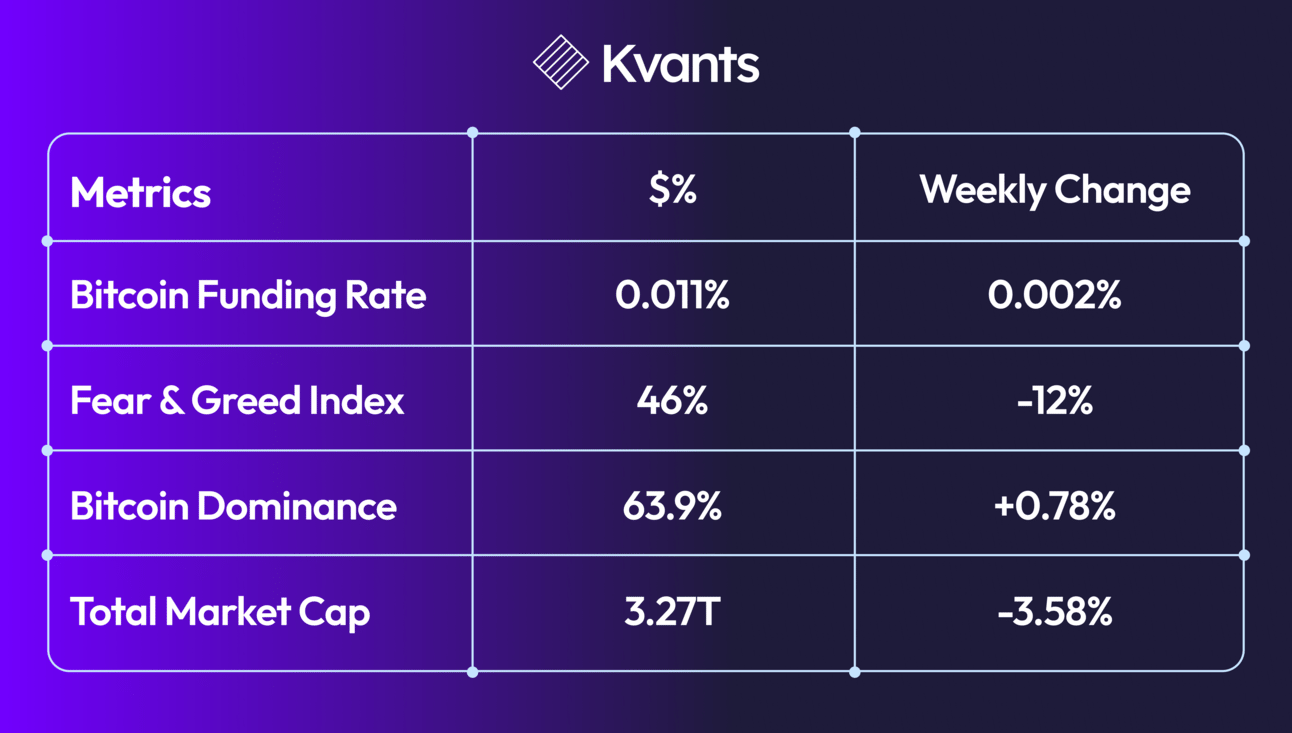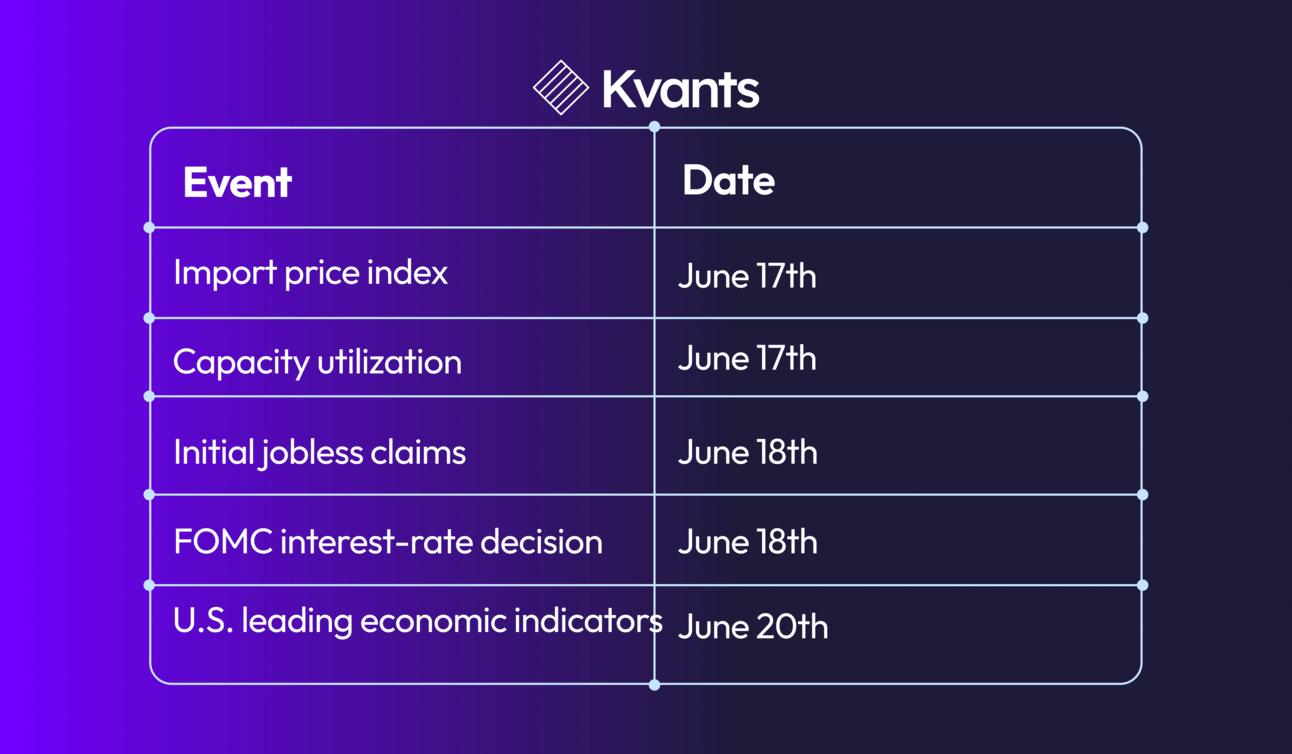- Kvants Newsletter
- Posts
- Kvants Weekly Insights: Santander announced plans to launch a euro-backed stablecoin and expand into retail crypto services
Kvants Weekly Insights: Santander announced plans to launch a euro-backed stablecoin and expand into retail crypto services

This week, Bybit secured a MiCA license and opened an EU base in Vienna. SharpLink Gaming acquired $463 million in Ethereum, becoming the largest public ETH treasury holder. An anonymous trader on Hyperliquid lost nearly $100 million following a leveraged BTC position liquidation. Santander is exploring a euro-backed stablecoin and retail crypto services. Long-term BTC holders continue to accumulate amid low volatility. Bitwise analysts estimate Bitcoin’s fair value between $200K–$230K. HYPE token surged over 12% as altcoins rebounded. Marathon Digital reported a record-high 950 BTC mined in May. Trump addressed Coinbase’s summit, outlining pro-crypto policies. Deutsche Telekom, Vodafone, and Alibaba Cloud are running nodes on Nillion. Tether acquired a 32% stake in Canadian gold royalty firm Elemental Altus. Panama City’s mayor proposed Bitcoin-based canal priority. Hong Kong is developing a crypto tracking tool for anti-money laundering.


Bybit Secures MiCA License in Austria, Opens EU Base in Vienna
Bybit obtained its MiCA license from Austria’s FMA, fully enabling it to operate across the 29-member European Economic Area under the upcoming EU regulations. This approval is complemented by the opening of a regional HQ in Vienna, underscoring long-term strategic commitment. Bybit is among the first major global exchanges to gain MiCA ahead of its formal 2025 rollout. The move positions them well for institutional onboarding in a tightly regulated European market. LINK
IMPORTANCE:
Bybit’s proactive MiCA compliance signals a strategic pivot: regulatory legitimacy is now a competitive moat. Early entry into European markets affords Bybit first-mover status on institutional relationships and compliance credibility. This could set a precedent for non-EU exchanges racing for approval to avoid being excluded. Institutional allocators should treat MiCA licenses as gatekeeping filters for trusted partners. Expect accelerated EU market share consolidation among compliant players.
SharpLink Gaming Buys $463 Million in Ethereum, Becomes Largest ETH Treasury Firm
SharpLink Gaming has acquired 176,271 ETH, valued at approximately $463 million, making it the largest public holder of Ethereum by treasury size. The purchase was funded through a $79 million at-the-market equity raise, with most of the ETH allocated to staking and liquid staking strategies. SharpLink said the move aligns with its broader pivot into blockchain infrastructure and treasury optimization. This acquisition vaults Ethereum into the same corporate asset category once dominated solely by Bitcoin. LINK
IMPORTANCE:
This marks a significant evolution in digital asset allocation strategy. ETH is no longer just a yield-generating layer; it’s now a primary treasury reserve for public companies. SharpLink’s aggressive entry signals institutional readiness to treat Ethereum as a programmable, staked capital base with both monetary and operational utility. It further validates staking as a treasury-level yield mechanism. For asset managers, this may catalyze similar ETH-weighted balance sheet moves across tech and gaming sectors. The strategic implications go beyond price, this is a structural endorsement of Ethereum’s financial infrastructure layer.
Hyperliquid Whale Faces Nearly $100M Loss After Bitcoin Dips Below $105K
An anonymous trader on Hyperliquid suffered nearly $100 million in liquidations after Bitcoin dipped under $105,000, following a highly leveraged $1 billion long position. On-chain data revealed cascading liquidations that exacerbated BTC’s volatility during the sell-off. The event highlights the risk of outsized leverage in DeFi platforms with limited risk infrastructure. It reinforces concerns about systemic fragility in decentralized exchange ecosystems. LINK
IMPORTANCE:
This liquidation event serves as a stark reminder that DeFi’s transparency doesn’t equate to risk control. Excessive leverage in smart contracts without margin safeguards poses significant threat vectors. Returns may look attractive but losing nearly $100 million in a single event shows why institutional-grade platforms need robust risk management. For allocators, this underlines the importance of assessing leverage mechanics before deployment. It’s increasingly clear: on-chain alpha requires counterparty-quality infrastructure.
Santander Considers Issuing Stablecoin and Retail Crypto Services
Spanish banking giant Santander is exploring the launch of a euro-backed stablecoin and retail crypto services under the MiCA framework. Internal evaluations are underway, signaling strategic alignment with evolving EU regulations. Executives noted growing customer demand and an intent to lead compliance-first innovation. If launched, Santander would be among the first major European banks to issue a stablecoin. LINK
IMPORTANCE:
Santander’s potential entry into stablecoins marks a notable shift in how Tier 1 banks are beginning to view crypto not as a threat, but as an extension of their core infrastructure. A euro-backed stablecoin from a regulated institution could serve as a high-trust on-ramp for both consumers and corporates. The timing is strategic: MiCA provides the legal scaffolding, and Santander appears ready to be first-mover among traditional banks. This would also put pressure on regional competitors to respond, potentially accelerating stablecoin adoption across the EU banking sector.
“Unique” Bitcoin Holder Trend Backs BTC’s Next Price Discovery Phase
Long-term Bitcoin holders continue accumulating even as short-term participants take profits, according to Glassnode analytics. BTC volatility sits in the lowest 10th percentile of its historical range, suggesting a compression phase. Past cycles show this type of structure often precedes either breakout rallies or sharp corrections. Current ownership dynamics reveal high conviction and declining liquid supply. LINK
IMPORTANCE:
This pattern indicates BTC’s structural maturity is strengthening. High conviction supply combined with low volatility offers asymmetric risk-reward. Institutional allocators should treat this as a strategic window, especially if macro conditions remain supportive. On-chain data is increasingly reliable for anticipating volatility breakouts. Expect sustained positioning shifts if accumulation continues uninterrupted.
Bitcoin’s “Fair Value” Could Be as High as $230K — Bitwise Analysts
Bitwise Asset Management estimates Bitcoin’s fair value between $200K–$230K, citing rising U.S. fiscal deficits, tax pressures, and global debt levels. The analysis links these macro trends with BTC’s scarcity and anti-inflation narrative. Technical setups suggest a bullish continuation of macro volatility persists. The call aligns with BTC’s post-halving supply dynamics and ETF demand surge. LINK
IMPORTANCE:
This valuation thesis positions Bitcoin as more than a risk asset, it’s emerging as a macro hedge. Fiscal deterioration globally may elevate BTC’s safe-haven appeal. Quant desks should model this in relation to debt servicing stress and fiat dilution. This framework provides anchoring for high-conviction, long-duration exposure. Long-term allocators will benefit from using these fair value ranges as accumulation benchmarks.
Hyperliquid Token (HYPE) Leads Altcoin Rebound as Bitcoin Stabilizes
The Hyperliquid protocol’s native token HYPE surged over 12% while Bitcoin stayed relatively flat. The move reflects optimism in DEX platforms and growing confidence in their liquidity frameworks. Other large-cap altcoins also rebounded modestly, suggesting early signs of rotation. Analysts view HYPE as a sentiment proxy for on-chain derivatives strength. LINK
IMPORTANCE:
HYPE’s rise underscores the growing appeal of decentralized trading infrastructure in a stable BTC environment. Performance gaps like this offer tactical entries for rotation strategies. Momentum in DEX-native assets could outpace legacy alts. For allocators, this is a cue to re-examine sector composition and DEX exposure. DEX governance and token incentives may drive next-phase outperformance.
MARA Hits Record-High Bitcoin Production in May
Marathon Digital mined 950 BTC in May. Its highest monthly production to date is up 35% from April. The firm’s efficiency upgrades and expanded capacity were key drivers. The milestone comes as BTC prices remain strong, enhancing margins. Marathon remains one of the largest institutional players in the mining space. LINK
IMPORTANCE:
MARA’s output shows mining capital deployment is accelerating alongside price recovery. For institutional miners, this validates scale economics in the post-halving environment. It also reinforces Bitcoin’s supply discipline and its ability to reward efficient operations. Miner metrics like cost per coin and hashrate are key inputs for valuation models. Expect MARA’s growth to set performance benchmarks for the sector.
Trump Addresses Coinbase Summit to Discuss Crypto Plans
Former President Trump delivered a prerecorded message at Coinbase’s “State of Crypto” Summit, asserting his identity as the “first crypto president” and highlighting his administration's support for stablecoin regulation and a national Bitcoin reserve. He reaffirmed backing for the GENIUS Act, which aims to create regulatory clarity for dollar-backed stablecoins. Trump emphasized the formation of a federal crypto working group to streamline oversight. The address signals continued political positioning of crypto as a bipartisan economic lever. LINK
IMPORTANCE:
Trump’s remarks reinforce crypto’s increasing visibility in U.S. federal policymaking—even ahead of his re-election campaign. The GENIUS Act and working group signal potential for clearer regulatory frameworks, reducing execution risk for industry actors. Strategists should interpret this as political endorsement that may ease investor hesitancy. The message may mobilize stakeholders across party lines, lending credence to crypto’s appeal beyond ideological camps. This sets the context for political timing in policy-driven market strategies.
Deutsche Telekom, Alibaba Cloud, Vodaphone Running Nodes on Nillion
Deutsche Telekom, Alibaba Cloud, and Vodafone are deploying nodes on Nillion’s new Enterprise Cluster, a privacy-first decentralized compute network. The pilot aims to enable encrypted data operations without sacrificing security—catered to sectors like healthcare and finance. Partnering with global telecom and cloud giants underscores Nillion’s move into mainstream enterprise infrastructure. This broader node adoption highlights the commercial readiness of privacy-preserving blockchain stacks. LINK
IMPORTANCE:
This initiative marks a shift: blockchain isn’t just a financial tool—it’s entering core enterprise data infrastructure. Involvement from telecom majors like Vodafone and Alibaba validates Nillion’s architectural credibility. For allocators, this suggests infrastructure opportunity in privacy-driven blockchain tech. As data sovereignty becomes a global priority, early network participants gain strategic advantage. It foreshadows investment themes that bridge enterprise software, telecom, and decentralized infrastructure.
USDT Issuer Tether Buys 32% Stake in Canadian Gold Royalty Firm
Tether Investments acquired a 31.9% stake in Elemental Altus Royalties, a Canadian gold royalty company, investing approximately US$89 million. The investment amplifies its diversification into hard-asset-backed financial infrastructure. Tether framed this as a “dual pillar strategy,” pairing gold exposure with its substantial BTC reserves. The move signals Tether’s intent to anchor USD₮ with a multi-asset collateral base. LINK
IMPORTANCE:
Tether’s expansion into gold royalties firm validates hard-asset integration into stablecoin collateral models. Diversifying away from crypto-only reserves adds credibility to USD₮ as a stable value anchor. It could influence larger stablecoin issuers to follow suit in multi-asset collateralization. For financial infrastructure investors, this highlights a cross-asset strategy blending crypto and real-world assets. If adopted industry-wide, it could reshape stablecoin issuance frameworks and ledger considerations.
Panama City Mayor Proposes Bitcoin Priority for Canal Transit
Panama City’s mayor has proposed offering transit priority through the Panama Canal to ships paying with Bitcoin, as part of a broader effort to promote Panama as a crypto-forward country. The move is designed to attract blockchain-based financial and logistic innovation to the region. Discussions centered on incentivizing faster processing for BTC-paying firms. Though still at the proposal stage, it has sparked debate over the role of digital assets in sovereign supply chains. LINK
IMPORTANCE:
This proposal adds a novel twist to sovereign use-case innovation for Bitcoin, extending beyond finance into infrastructure policy. Even if symbolic, it reflects how local governments are experimenting with crypto incentives as economic development tools. Such initiatives can generate cross-border ripple effects, prompting other trade hubs to explore similar measures. It also highlights Bitcoin’s potential dual role: a monetary store of value and an exchange medium. Institutional investors might take this as an early indicator of regulatory openness in emerging jurisdictions.
Hong Kong to Develop Crypto Tracking Tool for Money Laundering
Hong Kong Customs and Excise Department, in collaboration with the University of Hong Kong, are building a crypto transaction tracing tool to address rising money laundering tied to virtual assets. The initiative responds to approximately 39 major laundering cases, with HK$229 million tied to crypto in one high-profile example. The tool is expected to support transnational enforcement with local and regional cooperation. Officials emphasize this effort is necessary to combat increasingly complex, cross-border illicit finance channels. LINK
IMPORTANCE:
This development illustrates that crypto surveillance capabilities are a regulatory priority in APAC—even in crypto-forward jurisdictions. For exchanges and custodians, technical tracing infrastructure adds compliance pressure. Investors should anticipate tighter enforcement frameworks across global hubs. The move signals that regulatory clarity now leans heavily on enforceability tools. This could increase complexity—and cost—for protocols operating at international scale.

